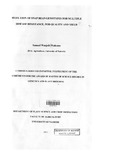| dc.description.abstract | Snap bean (Phaseolus vulgaris L.) is a major vegetable export crop in Kenya, and it is produced
mainly by small scale farmers and multinational companies. Angular leaf spot, anthracnose and
rust diseases cause crop losses up to 100% on susceptible cultivars of snap bean. Use of chemical
is expensive and reduces profitability of snap bean farming and it is not environment and
consumer friendly. Therefore, the objective of this study was to select snap bean populations and
advanced snap bean lines for multiple disease resistance, pod quality and yield.
Snap beans used in this study included populations developed from BelDakMi, BelMiNeb and
Beltigrade lines with resistance to rust, G2333 for resistance to anthracnose, L227 with
resistance to angular leaf spot and rust, and the popular varieties that have good pod quality.
These populations were advanced by bulk method to F4, F5, and F6 generations. Thirty three bush
snap bean lines and six climbing lines were also evaluated. The experiments were conducted at
KARI- Thika and Mwea for two seasons during 2009 and 2010. The experiments in both locations
laid down in split plot design with three replicates. The populations and lines were artificially
inoculated with isolates of angular leaf spot, anthracnose and rust at triofoliate stage. Data
collected included disease severity, days to flowering and maturity, pod length and width, number
of pods per plant, marketable pod yield, pod quality (extra fine, fine and bobby) and seed yield.
Analysis of variance showed that disease severity was significantly influenced by cropping
season, location, fungicide application and genotype. High disease severity was recorded during
long rain season at Thika location when genotypes were grown without application of fungicide.
The disease with the highest severity was rust followed by angular leaf spot. Among the
advanced lines two bush lines KSB lOW and KSB 10 BR and one climbing line HAV 130 had
consistent multiple resistance to angular leaf spot, anthracnose and rust at both locations.
Resistant genes in the three lines reduced the mean disease severity by 17%, 16% and 36%, for
angular leaf spot, anthracnose and rust respectively when compared with commercial varieties.
There were significant differences among the genotypes with respect to marketable pod yield,
pod quality and seed yield. Star 2053 had the-highest pod yield of 11.5 t ha-1 among the parents
while HAB 428 had the highest pod yield of 8.5 t ha-1 among the evaluated lines. Single plants
combining resistance to the three diseases and desirable pod characteristics were selected from
the segregating populations. Among the advanced snap bean lines selected for having multiple
disease resistance, HAB 501 had the highest pod yield of 10.9 t ha-1 while KSB 10 BR had the
highest extra fine pod yield of 2.0 t ha' . All climbing lines had thicker pods of 11 mm compared
to bush lines with a mean pod diameter of 8 mm when harvested at a regular interval. Among the
parent lines Paulista had the highest seed yield of 1.0 t ha-1 while HAV 135 had the highest seed
yield of 2.4 t ha-1 among snap bean lines.
Snap bean genotypes with multiple resistance to angular leaf spot, anthracnose and rust were
identified. This shows that the parents used to develop the snap bean population and lines have
resistance genes that could be exploited in the development of snap bean varieties with disease
resistance. Although some of the advanced lines had multiple disease resistance, most did not
meet the desired yield and quality of the.bush commercial varieties. Therefore, there is need for
continued development of snap bean lines with multiple disease resistance and high yields of
acceptable quality from the identified single plant selections. | en |

